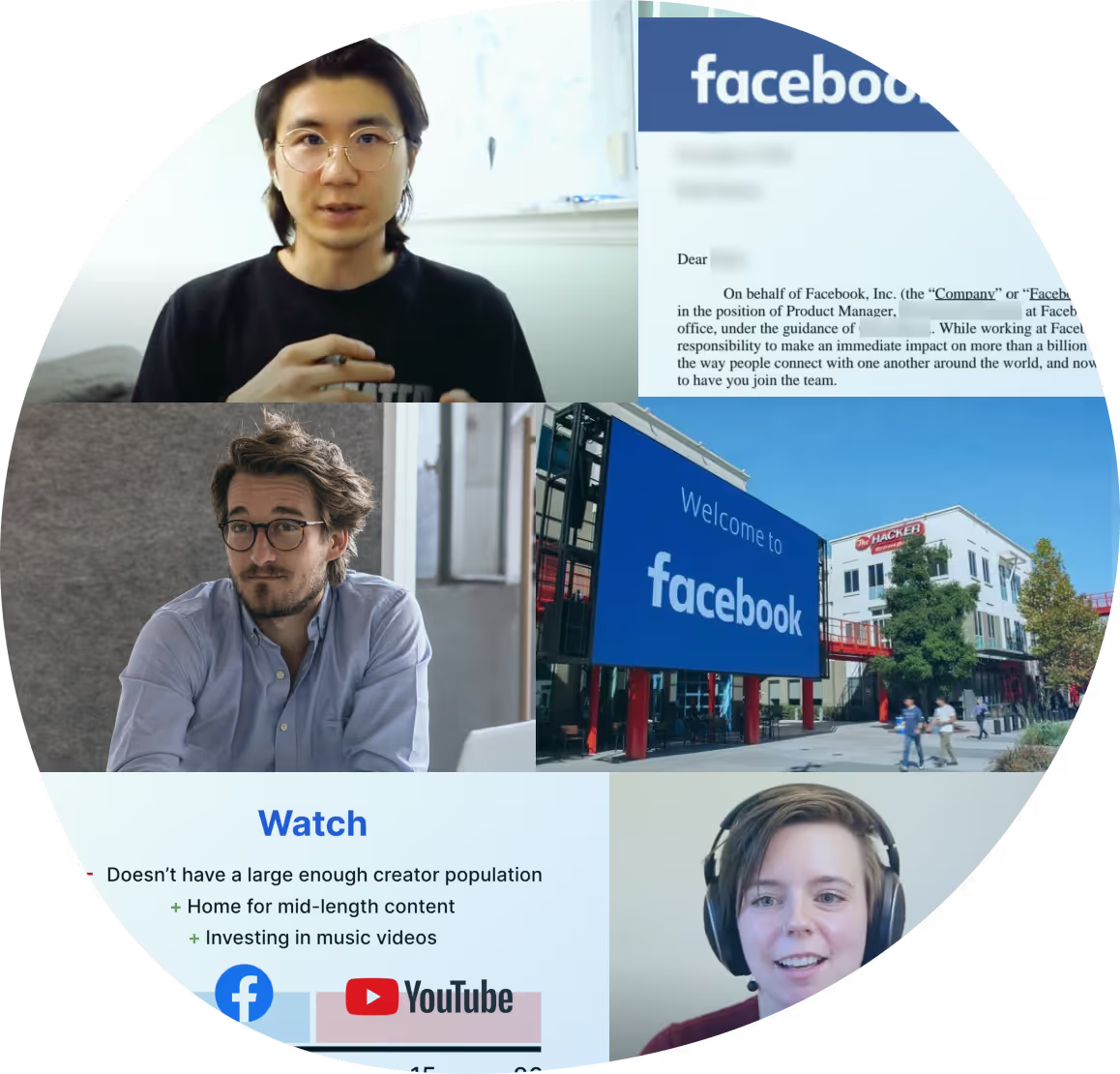With over 3.5 billion monthly active users across its family of apps, few companies can compete with the sheer amount of usage and impact a product career at Meta can offer. Meta hires approximately 200 PMs across their Menlo Park, San Francisco, Seattle, New York City, Boston, Tel Aviv and London offices however they receive north of 50,000 applications each year.

Something notable about product recruiting at Meta compared to other tech giants such as Google and Microsoft is that Meta doesn’t require its PMs to come from a technical background. What this means is that the PM role at Meta is much more product strategy orientated rather than technical project management focused.
Week 0
Submit your resume and get referrals.
Week 2
Initial phone screen with a recruiter. Covers behavioral questions, including why you want to work at Meta and why you want to do PM.
Week 4
Two phone interviews with product managers. One interview will evaluate your product sense, while the other will test your execution skills.
Week 6
Three onsite interviews. One covers product sense (design and strategy), one covers execution (data analysis and prioritization), and the last covers leadership and drive.

The product development framework that every Meta PM is taught during PM Bootcamp for new hires at Meta is Understand, Identify, Execute which means:
While this framework is taught once you join the company, the PM hiring committee at Meta is looking for candidates who intuitively use some variant of this framework already. The Product Sense interview evaluates your ability to Understand and Identify, while the Execution interview is focused on understanding if you make the decisions necessary to get things done and prioritize effectively.
Unlike most other companies, Meta’s Execution interview focuses much more on data driven decision making rather than project management.
This interview will ask you to put yourself in the shoes of a Meta PM and force you to evaluate different trade-offs, figure out the right metric to track, remove roadblocks for your team etc. This interview is meant to assess if you can make sound decisions and tactically get the right things done on a daily basis to build your product vision.
This interview usually is comprised of 4–5 behavioral questions and is meant to help access if you can effectively lead and inspire a product team, deal with conflict, facilitate communication, etc.
How would you measure the success of Facebook Dating?

The product sense interview will test if you can turn a big ambiguous problem space into a great product that can potentially create value for billions of people.
Meta PMs are taught to not discuss DAU or MAU, which are common terms at nearly all other tech companies. Instead, they consider DAP and MAP, which are daily active people and monthly active people respectively. This is because a core tenant of Meta is creating products which solve real people problems rather than the company’s problems.
Product Sense Interview Questions will typically be in the form of one very deep hypothetical “what would you build for x” with a series of follow-up questions to understand your thought process.
Unlock more premium Meta PM interview videos for free

Leadership at Meta is driven by influence rather than formal authority. Thus Meta PMs are able to build strong relationships across engineering, design, data science, UX research, content strategy, legal and more to drive impact. The leadership and drive portion of the interview also ties back to the understand, identify, and execute framework. While good PMs are able to analyze problems from this lens, great PMs can bring all their cross-functional peers along the journey as well and help them collectively understand the problem, identify the right solution, and perfectly execute that solution.
The Product Sense and Execution interviews focus on how you think about current and future Meta products. In contrast, the Leadership & Drive interview focuses on your past experiences and is meant to help assess if you can effectively lead and inspire a product team, deal with conflict, facilitate communication, etc.
If you see the role of the PM to be the CEO of a product, Meta is likely not the place for you.

Created with the help of 14 current and former Facebook PMs, including 6 M1 and M2 Product Leads and 2 D1 Hiring Managers
12 hours of video lessons
Facebook Company Level Strategic Overview & Monthly Updated Most Common PM Interview Questions
Lifetime access
Tax deductible expense under continuous education category (USA)
In our Flagship Meta PM Interview course, you’ll start off by learning Meta’s strategy between now and 2030 for the core app, Instagram, Whatsapp, and more. Given how often Meta product interview questions focus on either existing Meta products or how Meta should enter new markets, understanding the C-Suite’s long term vision is absolutely critical for getting strong hire ratings.
From there, we will give you a refresher on the art of interviewing, covering everything from whiteboarding to body language. We’ll reveal every variation of Product Sense, Execution and Leadership and Drive questions you are likely to get asked at Meta and then walk you through the concrete things that Meta interviewers are taught to look for in your response for each question type. We’ll also show you tons of mock interview examples of 10 out of 10 answers with expert interviewer commentary along the way.
Finally, we will share a monthly updated list of interview questions that our team members and past customers have actually gotten during their recent Meta PM interviews. With this course, you can take luck out of the equation for getting your dream PM job at Meta!
The step by step playbook for consistently getting “Strong Hire” ratings and converting your Meta interviews into a top bracket PM offer letter.


Henry Soong got the job at
Pedro got the job at
Product Manager

The comprehensive tool to help you succeed in landing a PM job.
Product Alliance is the comprehensive tool to help you succeed in landing a product management job.
In our Flagship Meta PM Interview course, you’ll start off by learning Meta's strategy between now and 2030 for Facebook, Instagram, WhatsApp, and more. Given how often Meta product interview questions focus on either existing Meta products or how Meta should enter new markets, understanding the C-Suite’s long term vision is absolutely critical for getting strong hire ratings.
From there, we will give you a refresher on the art of interviewing, covering everything from whiteboarding to body language. We’ll reveal every variation of Product Sense, Analytical Thinking, and Leadership and Drive questions you are likely to get asked at Meta and then walk you through the concrete things that Meta interviewers are taught to look for in your response for each question type. We’ll also show you tons of mock interview examples of 10 out of 10 answers with expert interviewer commentary along the way.
Finally, we will share a monthly updated list of interview questions that our team members and past customers have actually gotten during their recent Meta PM interviews. With this course, you can take luck out of the equation for getting your dream PM job at Meta!


6,000+
total customers
.gif)
13 hours
of HD video lessons

38%
avg. increase in TC
Google’s product strategy centers on user-first design, AI-driven innovation, and a connected ecosystem that blends free, ad-supported tools with paid enterprise services to drive engagement and growth.
Google’s product strategy centers on user-first design, AI-driven innovation, and a connected ecosystem that blends free, ad-supported tools with paid enterprise services to drive engagement and growth.




Google’s product strategy centers on user-first design, AI-driven innovation, and a connected ecosystem that blends free, ad-supported tools with paid enterprise services to drive engagement and growth.

The #1 mistake PM candidates make during the Meta Analytical Thinking interview
The #1 mistake PM candidates make during the Meta Analytical Thinking interview

The #1 mistake PM candidates make during the Meta Analytical Thinking interview
The #1 mistake PM candidates make during the Meta Analytical Thinking interview

Sample 10/10 answer: What metrics would you track if you were focused on improving Airbnb's check-in experience?
Sample 10/10 answer: What metrics would you track if you were focused on improving Airbnb's check-in experience?

Sample 10/10 answer: What metrics would you track if you were focused on improving Airbnb's check-in experience?
Sample 10/10 answer: What metrics would you track if you were focused on improving Airbnb's check-in experience?
Sample 10/10 answer: Imagine you were the PM on Uber's driver app. What key metrics would you be looking at?
Sample 10/10 answer: Imagine you were the PM on Uber's driver app. What key metrics would you be looking at?

Sample 10/10 answer: Imagine you were the PM on Uber's driver app. What key metrics would you be looking at?
Sample 10/10 answer: Imagine you were the PM on Uber's driver app. What key metrics would you be looking at?
Sample 10/10 answer: Build an ML model to predict granola bar sales in a given Walmart store. Your model can only take in 10 variables.
Sample 10/10 answer: Build an ML model to predict granola bar sales in a given Walmart store. Your model can only take in 10 variables.

Sample 10/10 answer: Build an ML model to predict granola bar sales in a given Walmart store. Your model can only take in 10 variables.
Sample 10/10 answer: Build an ML model to predict granola bar sales in a given Walmart store. Your model can only take in 10 variables.
Sample 10/10 answer: How would you measure the success of Facebook Dating?
Sample 10/10 answer: How would you measure the success of Facebook Dating?

Sample 10/10 answer: How would you measure the success of Facebook Dating?
Sample 10/10 answer: How would you measure the success of Facebook Dating?

Sample 10/10 answer: Imagine Microsoft Teams saw a 50% drop in downloads overnight. How would you figure out what happened?
Sample 10/10 answer: Imagine Microsoft Teams saw a 50% drop in downloads overnight. How would you figure out what happened?

Sample 10/10 answer: Imagine Microsoft Teams saw a 50% drop in downloads overnight. How would you figure out what happened?
Sample 10/10 answer: Imagine Microsoft Teams saw a 50% drop in downloads overnight. How would you figure out what happened?
Sample 10/10 answer: A Snapchat app redesign increases time spent but reduces Snaps sent & stories shared. Should you ship it?
Sample 10/10 answer: A Snapchat app redesign increases time spent but reduces Snaps sent & stories shared. Should you ship it?

Sample 10/10 answer: A Snapchat app redesign increases time spent but reduces Snaps sent & stories shared. Should you ship it?
Sample 10/10 answer: A Snapchat app redesign increases time spent but reduces Snaps sent & stories shared. Should you ship it?

Sample 10/10 answer: Suppose you're Marriott's CEO and found that a hack just exposed the data of 5 million guests. What would you do?
Sample 10/10 answer: Suppose you're Marriott's CEO and found that a hack just exposed the data of 5 million guests. What would you do?

Sample 10/10 answer: Suppose you're Marriott's CEO and found that a hack just exposed the data of 5 million guests. What would you do?
Sample 10/10 answer: Suppose you're Marriott's CEO and found that a hack just exposed the data of 5 million guests. What would you do?
Sample 10/10 answer: You promised Best Buy that you'd launch the latest version of Google's Pixel Buds in September, but the engineering team says it won't be ready until December. What do you do?
Sample 10/10 answer: You promised Best Buy that you'd launch the latest version of Google's Pixel Buds in September, but the engineering team says it won't be ready until December. What do you do?

Sample 10/10 answer: You promised Best Buy that you'd launch the latest version of Google's Pixel Buds in September, but the engineering team says it won't be ready until December. What do you do?
Sample 10/10 answer: You promised Best Buy that you'd launch the latest version of Google's Pixel Buds in September, but the engineering team says it won't be ready until December. What do you do?

Google’s product strategy centers on user-first design, AI-driven innovation, and a connected ecosystem that blends free, ad-supported tools with paid enterprise services to drive engagement and growth.

The secret playbook for mastering the Meta Product Sense interview (and its follow-up questions)
The secret playbook for mastering the Meta Product Sense interview (and its follow-up questions)

The secret playbook for mastering the Meta Product Sense interview (and its follow-up questions)
The secret playbook for mastering the Meta Product Sense interview (and its follow-up questions)
The most common mistake candidates make in the Meta Product Sense interview
The most common mistake candidates make in the Meta Product Sense interview

The most common mistake candidates make in the Meta Product Sense interview
The most common mistake candidates make in the Meta Product Sense interview

Sample 10/10 answer: Should TikTok build a video scrubber to allow users to skip to certain time stamps?
Sample 10/10 answer: Should TikTok build a video scrubber to allow users to skip to certain time stamps?

Sample 10/10 answer: Should TikTok build a video scrubber to allow users to skip to certain time stamps?
Sample 10/10 answer: Should TikTok build a video scrubber to allow users to skip to certain time stamps?
Sample 10/10 answer: Imagine you're the PM in charge of building a podcast product on the Facebook app. What would you build?
Sample 10/10 answer: Imagine you're the PM in charge of building a podcast product on the Facebook app. What would you build?

Sample 10/10 answer: Imagine you're the PM in charge of building a podcast product on the Facebook app. What would you build?
Sample 10/10 answer: Imagine you're the PM in charge of building a podcast product on the Facebook app. What would you build?
Sample 10/10 answer: Design a better way to find a roommate in a new city.
Sample 10/10 answer: Design a better way to find a roommate in a new city.

Sample 10/10 answer: Design a better way to find a roommate in a new city.
Sample 10/10 answer: Design a better way to find a roommate in a new city.

Sample 10/10 answer 1: Pick your favorite product. How would you improve it?
Sample 10/10 answer 1: Pick your favorite product. How would you improve it?

Sample 10/10 answer 1: Pick your favorite product. How would you improve it?
Sample 10/10 answer 1: Pick your favorite product. How would you improve it?
Sample 10/10 answer 2: Pick your favorite product. How would you improve it?
Sample 10/10 answer 2: Pick your favorite product. How would you improve it?

Sample 10/10 answer 2: Pick your favorite product. How would you improve it?
Sample 10/10 answer 2: Pick your favorite product. How would you improve it?
Sample 10/10 answer: You work at Netflix and find that many videos are freezing in the middle to buffer. How would you improve this experience?
Sample 10/10 answer: You work at Netflix and find that many videos are freezing in the middle to buffer. How would you improve this experience?

Sample 10/10 answer: You work at Netflix and find that many videos are freezing in the middle to buffer. How would you improve this experience?
Sample 10/10 answer: You work at Netflix and find that many videos are freezing in the middle to buffer. How would you improve this experience?


How to flawlessly answer Product Launch questions

Sample 10/10 answer: How would you decide which country to next launch Amazon Prime 1- or 2-day shipping in?

Sample 10/10 answer: Twitter wants to find more ways to monetize without adding more ads. What do you suggest?
Sample 10/10 answer: Twitter wants to find more ways to monetize without adding more ads. What do you suggest?

Sample 10/10 answer: Twitter wants to find more ways to monetize without adding more ads. What do you suggest?
Sample 10/10 answer: Twitter wants to find more ways to monetize without adding more ads. What do you suggest?
Sample 10/10 answer: Create a zero-budget growth strategy for a free app that helps users find great flight deals.
Sample 10/10 answer: Create a zero-budget growth strategy for a free app that helps users find great flight deals.

Sample 10/10 answer: Create a zero-budget growth strategy for a free app that helps users find great flight deals.
Sample 10/10 answer: Create a zero-budget growth strategy for a free app that helps users find great flight deals.
Sample 10/10 answer: How would you use $30 million to design a referral program for Lyft to drive 1 million new signups?
Sample 10/10 answer: How would you use $30 million to design a referral program for Lyft to drive 1 million new signups?

Sample 10/10 answer: How would you use $30 million to design a referral program for Lyft to drive 1 million new signups?
Sample 10/10 answer: How would you use $30 million to design a referral program for Lyft to drive 1 million new signups?
Sample 10/10 answer: OfferUp, a peer-to-peer local marketplace startup, wants to attract more sellers. What should it do?
Sample 10/10 answer: OfferUp, a peer-to-peer local marketplace startup, wants to attract more sellers. What should it do?

Sample 10/10 answer: OfferUp, a peer-to-peer local marketplace startup, wants to attract more sellers. What should it do?
Sample 10/10 answer: OfferUp, a peer-to-peer local marketplace startup, wants to attract more sellers. What should it do?

Sample 10/10 answer: Should Instagram let users pay for an ad-free experience? If so, how much would you charge for it?
Sample 10/10 answer: Should Instagram let users pay for an ad-free experience? If so, how much would you charge for it?

Sample 10/10 answer: Should Instagram let users pay for an ad-free experience? If so, how much would you charge for it?
Sample 10/10 answer: Should Instagram let users pay for an ad-free experience? If so, how much would you charge for it?
Sample 10/10 answer: Target is a longtime Azure customer and wants a 10% discount for next year. As a PM at Azure, would you grant it?
Sample 10/10 answer: Target is a longtime Azure customer and wants a 10% discount for next year. As a PM at Azure, would you grant it?

Sample 10/10 answer: Target is a longtime Azure customer and wants a 10% discount for next year. As a PM at Azure, would you grant it?
Sample 10/10 answer: Target is a longtime Azure customer and wants a 10% discount for next year. As a PM at Azure, would you grant it?

Google’s product strategy centers on user-first design, AI-driven innovation, and a connected ecosystem that blends free, ad-supported tools with paid enterprise services to drive engagement and growth.



Sample 10/10 answer: Tell me about a time you didn't have the resources to do something but got it done anyway.
Sample 10/10 answer: Tell me about a time you didn't have the resources to do something but got it done anyway.

Sample 10/10 answer: Tell me about a time you didn't have the resources to do something but got it done anyway.
Sample 10/10 answer: Tell me about a time you didn't have the resources to do something but got it done anyway.
Sample 10/10 answer: Tell me about a time when you built something outside of work.
Sample 10/10 answer: Tell me about a time when you built something outside of work.

Sample 10/10 answer: Tell me about a time when you built something outside of work.
Sample 10/10 answer: Tell me about a time when you built something outside of work.
Sample 10/10 answer: Tell me about a time you had to overcome an obstacle.
Sample 10/10 answer: Tell me about a time you had to overcome an obstacle.

Sample 10/10 answer: Tell me about a time you had to overcome an obstacle.
Sample 10/10 answer: Tell me about a time you had to overcome an obstacle.
Sample 10/10 answer: Tell me about a time you created an innovative product.
Sample 10/10 answer: Tell me about a time you created an innovative product.

Sample 10/10 answer: Tell me about a time you created an innovative product.
Sample 10/10 answer: Tell me about a time you created an innovative product.
Sample 10/10 answer: Tell me about a time you had to make a really tough decision.
Sample 10/10 answer: Tell me about a time you had to make a really tough decision.

Sample 10/10 answer: Tell me about a time you had to make a really tough decision.
Sample 10/10 answer: Tell me about a time you had to make a really tough decision.
Sample 10/10 answer: Describe an instance where you had to make an important decision.
Sample 10/10 answer: Describe an instance where you had to make an important decision.

Sample 10/10 answer: Describe an instance where you had to make an important decision.
Sample 10/10 answer: Describe an instance where you had to make an important decision.

Sample 10/10 answer: Imagine if the designer on your team wasn't meeting expectations. How would you proceed?
Sample 10/10 answer: Imagine if the designer on your team wasn't meeting expectations. How would you proceed?

Sample 10/10 answer: Imagine if the designer on your team wasn't meeting expectations. How would you proceed?
Sample 10/10 answer: Imagine if the designer on your team wasn't meeting expectations. How would you proceed?
Sample 10/10 answer: Tell me about a time when you earned the trust of a person or group.
Sample 10/10 answer: Tell me about a time when you earned the trust of a person or group.

Sample 10/10 answer: Tell me about a time when you earned the trust of a person or group.
Sample 10/10 answer: Tell me about a time when you earned the trust of a person or group.

Sample 10/10 answer: Do you stay up to date with the tech industry? How do you get inspired with new ideas?
Sample 10/10 answer: Do you stay up to date with the tech industry? How do you get inspired with new ideas?

Sample 10/10 answer: Do you stay up to date with the tech industry? How do you get inspired with new ideas?
Sample 10/10 answer: Do you stay up to date with the tech industry? How do you get inspired with new ideas?

Google’s product strategy centers on user-first design, AI-driven innovation, and a connected ecosystem that blends free, ad-supported tools with paid enterprise services to drive engagement and growth.


Brief introduction to Meta's mission and how AI aligns with it

Overview of Meta's AI research and development areas

Key goals of Meta’s AI strategy: open innovation, personalization, safety

Introduction to Meta’s open-sourcing philosophy and its impact on the AI community


The philosophy behind Meta’s open-sourcing strategy

Key open-source AI projects from Meta (e.g., PyTorch, FAIR)

How open-sourcing accelerates AI research and innovation globally

The benefits and challenges of open-sourcing AI tools and technologies

Examples of community contributions and real-world applications


Introduction to LLaMA and its significance in the field of AI

Overview of LLaMA’s architecture, key features, and performance

How LLaMA is used within Meta’s platforms and its potential applications

The role of LLaMA in advancing natural language understanding and generation

The impact of LLaMA on the AI research community and its open-source availability


Overview of AI-driven personalization in Facebook, Instagram, and WhatsApp

The role of LLaMA and other AI models in content recommendation and curation

How AI enhances user engagement and satisfaction

Challenges and considerations in personalization, including privacy concerns

Examples of AI-driven features (e.g., personalized news feeds, relevant ad placements)


Overview of ongoing AI research at Meta, including LLaMA and other language models

The role of open-sourcing in shaping the future of AI at Meta

Ethical considerations and responsible AI development

Helping control the risks and costs of open source AI with Llama Guard 3

Meta’s vision for the future of AI in the Metaverse and beyond

Collaboration with academic institutions, startups, and industry partners

Closing thoughts on the potential of AI to transform Meta’s platforms and user experiences
39 video hrs
300+ pages
Lifetime access
Tax-deductible expense under the US's continuing education category
7
$850
$700
3:45:23 remaining










